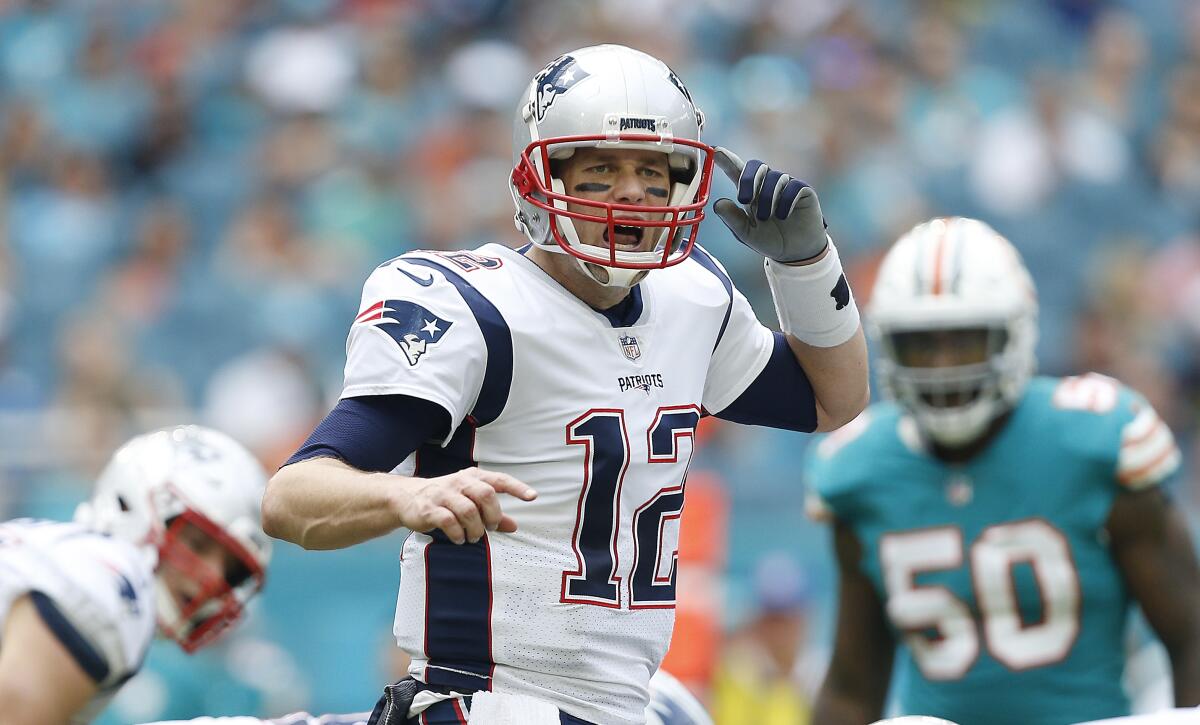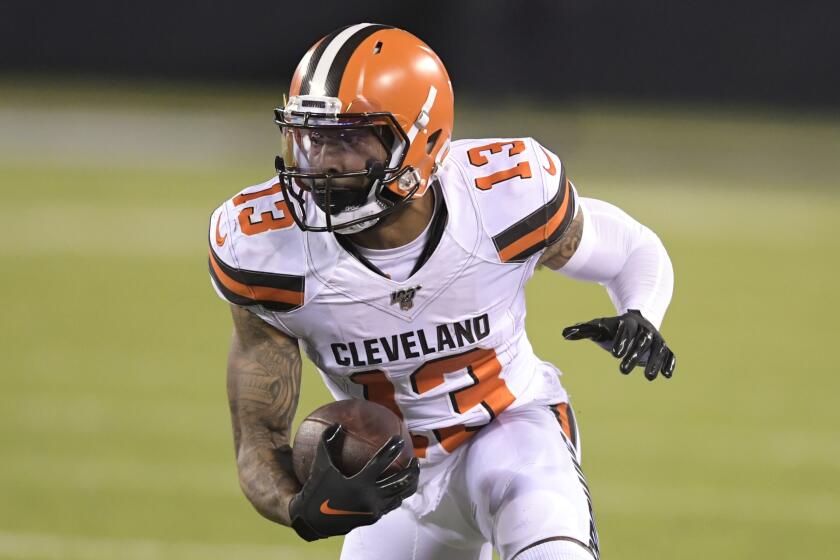Ask Sam Farmer: What are the basic mechanics of an NFL play call?

- Share via
Have a question about the NFL? Ask Times NFL writer Sam Farmer, and he will answer as many as he can online and in the Sunday editions of the newspaper throughout the season. Email questions to: sam.farmer@latimes.com
I’m interested to learn about play calling in the huddle. Back in the day they’d say, “Two-hole blast, on two.” Now, the quarterback is in there for 15 seconds calling signals that seem like you need an engineering degree to understand them. What are the basic mechanics of an NFL play call?
Bob Meeker, La Cañada
Farmer: Keeping in mind the terms and language vary, slightly or dramatically, from team to team, there are some rules of thumb. The basic play call is formation first, followed by any motion or shifting, then the actual play call that includes the pass protection and/or run scheme, the pass route(s), and the snap count. Again, that’s not an absolute, but common practice.
Many people in the pass-pattern world number the routes by using a three-digit system, working across the formation and starting with the wideout on the single-receiver side. So, for instance, a “973” would be that single receiver running a 9-route, the slot receiver running a 7-route, and a 3-route for the receiver outside of the slot.
Teams don’t want their systems to be too confusing, because with injuries and free agency, new players are constantly joining the team and need to get up to speed quickly.
With modern up-tempo offenses, some teams have gone to one-word play calls. That requires players to know what they are supposed to do on that specific word, based on the formation.
But to get a specific example, I asked former NFL quarterback Boomer Esiason to weigh in:
“There’s a lot that goes into it. That’s why a lot of rookie quarterbacks have a problem. Not only does he have to know what he and the other 10 guys on his team are doing, but he also has to figure out what the 11 guys in the other colored jerseys are doing.
Odell Beckham’s reputation as a game-breaker has served the Cleveland Browns well this season, and the Rams’ secondary knows it needs to stop him.
“Calling runs is a little bit easier. It’s pass protection where it gets kind of dicey. But it starts with this: You always have the same six players on the field offensively — five offensive linemen and the quarterback. The configuration of the other five guys will determine what pass protections you can call, so in a typical system you can have protections ranging from five to eight blockers. Rookies are so screwed up, they can have a certain pass protection called, then the wrong personnel group in the huddle with them. This creates quite the confusion.
“Let’s say it’s a ‘regular’ personnel group, which is two running backs, a tight end, and two receivers. A quarterback might say, ‘OK, guys, regulars in the group. Far double-wing right, hum short, 76, halfback shallow cross, on two. Ready, break.’
“So that’s starting with the personnel group on the field — regular — followed by ‘far double-wing right,’ which is your formation. That means the halfback is broken out of the backfield on the outside of the X, the wide receiver. That wide receiver is lined up on the other side of the tight end and the flanker. ‘Far’ tells the halfback he’s outside the receiver. ‘Double wing’ tells him he’s out of the backfield.
“Then I say ‘hum short.’ That means the halfback is coming in short motion. Hum denotes halfback. ‘Short motion’ means he’s in motion within the tackle on his side of the formation; he’s not coming all the way across the formation.
“And 76 would be the pass protection. The reason why it’s an even number is because the strength of my formation is on the right side. The strength is denoted by where the tight end is lined up.
“‘Halfback shallow cross’ is the play. That means the two wide receivers and the tight end all have to know their corresponding routes that go along with the halfback running the shallow cross. I have to read through my progressions to get me where I need to throw it. While the halfback is the highlighted person in the play, that doesn’t mean I can’t throw it to the other players, depending on what the defense is doing to me. Finally, ‘on two’ is the snap count.
“You have to spit that out in 10 seconds, and you hope you’re not met with blank stares.”
::
Even with an insurmountable lead in the final minutes of Sunday’s game, the Rams kept Jared Goff and other regulars on the field until the end. This seems contrary to Sean McVay’s decision to avoid injuries to his first-stringers by confining them to the bench for all four preseason games. Am I missing something?
James Fulton, Glendale
Farmer: That’s something that happens with NFL teams every week, and there are far more pronounced examples than the Rams versus Saints. What about New England’s 43-0 blowout of Miami? Tom Brady played the whole game for the Patriots, and he’s 42.
For an answer, I turned to Rick Neuheisel, who has coached in the NFL and collegiate ranks. Why do starting quarterbacks stay in the game, even when the outcome is essentially decided?
The only answer that matters going forward is how the Chargers now respond against Houston at 1:25 p.m. Sunday at Dignity Health Sports Park.
“It’s different in the NFL than it is in college football. There’s an unwritten rule that quarterbacks finish the game. I don’t know why necessarily, but there just is. Backups don’t go in. Maybe it’s not trying to show up the opposing coach.
“I know as a coach at the collegiate level, you didn’t want to put somebody in until the deal was done,” Neuheisel said. “Because having to put the starter back in is a terrible thing for the confidence of the kid you’re taking back out. So you always wait until you’re sure.
“But in the NFL it never happened. We never put backups in the game when we were in Baltimore, or at least very rarely, unless there was something wrong with the starter. But there’s no question I think people will be taking a look at it, especially given the attrition that’s going on at the position.”
More to Read
Go beyond the scoreboard
Get the latest on L.A.'s teams in the daily Sports Report newsletter.
You may occasionally receive promotional content from the Los Angeles Times.













